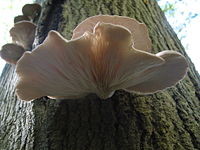
Photo from wikipedia
The azo dye Congo red is heavily used in textile industries and is actively present in the wastewater run-offs. Its structural complexity and physical characteristics make it resistant to the… Click to show full abstract
The azo dye Congo red is heavily used in textile industries and is actively present in the wastewater run-offs. Its structural complexity and physical characteristics make it resistant to the physicochemical treatments employed by the industry. Over time, application of the enzyme laccase has proved to be quite useful due to its ability to oxidize and eventually decolorize the dye. Moreover, the use of ABTS as the electron mediator also helps in enhancing the oxidizing capability of the enzyme with congo red. The present study involves establishing the role of the individual components i.e. laccase, ABTS and the dye, in the LMS electrochemically. Congo red doesn't have any form of electrochemical activity by itself, but the enzyme brings about a substantial change by increasing the rate of reduction. The effect of ABTS, though same, is concentration-dependent. For LMS, laccase helps in bringing about the rate of reduction much faster in the presence of the mediator, initiating the decolorization of the dye.
Journal Title: Enzyme and microbial technology
Year Published: 2020
Link to full text (if available)
Share on Social Media: Sign Up to like & get
recommendations!